英语备课表备课 -3
英语备课教案表格
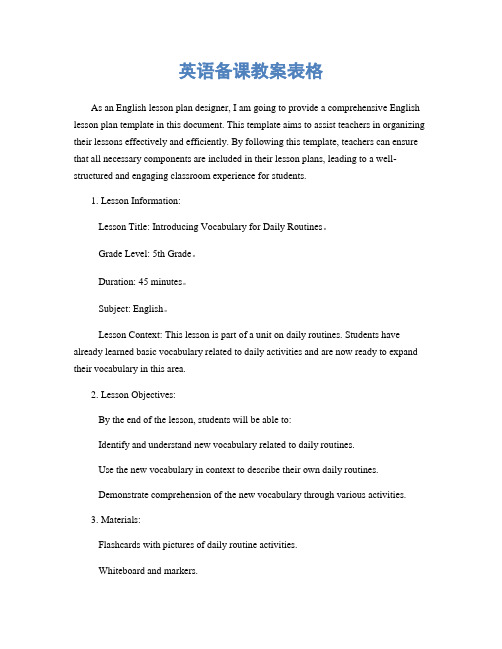
英语备课教案表格As an English lesson plan designer, I am going to provide a comprehensive English lesson plan template in this document. This template aims to assist teachers in organizing their lessons effectively and efficiently. By following this template, teachers can ensure that all necessary components are included in their lesson plans, leading to a well-structured and engaging classroom experience for students.1. Lesson Information:Lesson Title: Introducing Vocabulary for Daily Routines。
Grade Level: 5th Grade。
Duration: 45 minutes。
Subject: English。
Lesson Context: This lesson is part of a unit on daily routines. Students have already learned basic vocabulary related to daily activities and are now ready to expand their vocabulary in this area.2. Lesson Objectives:By the end of the lesson, students will be able to:Identify and understand new vocabulary related to daily routines.Use the new vocabulary in context to describe their own daily routines.Demonstrate comprehension of the new vocabulary through various activities.3. Materials:Flashcards with pictures of daily routine activities.Whiteboard and markers.Worksheets with fill-in-the-blank exercises.Real-life pictures depicting different daily routines.Interactive online resources for vocabulary practice (optional).4. Warm-up (5 minutes):Greet the students and review the previously learned vocabulary related to daily routines.Engage students in a quick discussion about their morning routines, encouraging them to use the vocabulary words they have already learned.5. Introduction of New Vocabulary (10 minutes):Present flashcards with new vocabulary words, such as "brush teeth," "take a shower," "eat breakfast," etc.Pronounce each word clearly and have students repeat after you to practice pronunciation.Show real-life pictures depicting different daily routines and ask students to match the pictures with the corresponding vocabulary words.6. Vocabulary Practice (15 minutes):Divide the class into pairs or small groups.Distribute worksheets with fill-in-the-blank exercises, where students need to complete sentences using the new vocabulary words.Monitor and provide assistance as needed.Review the answers as a whole class, allowing students to correct their own work.7. Application and Consolidation (10 minutes):Ask students to work in pairs again.Provide them with a scenario, such as planning a day out, and ask them to create a dialogue using the new vocabulary words.Encourage students to be creative and use the vocabulary words in context.Select a few pairs to perform their dialogues in front of the class.8. Wrap-up and Assessment (5 minutes):Review the new vocabulary words as a whole class.Ask students to write a short paragraph describing their own daily routines using the new vocabulary words.Collect the paragraphs for assessment purposes.9. Extension Activities (optional):Assign an online vocabulary game for students to practice the new words at home.Encourage students to create flashcards or posters with the new vocabulary words and display them in the classroom.By following this English lesson plan template, teachers can ensure that their lessons are well-structured and cover all necessary components. This template provides a clear framework for introducing new vocabulary, practicing it in context, and assessing students' understanding. Additionally, the suggested extension activities allow for further practice and reinforcement of the new vocabulary. With this comprehensive lesson plan template, teachers can create engaging and effective English lessons for their students.。
外研版必修一英语同步备课 UNIT3F~2
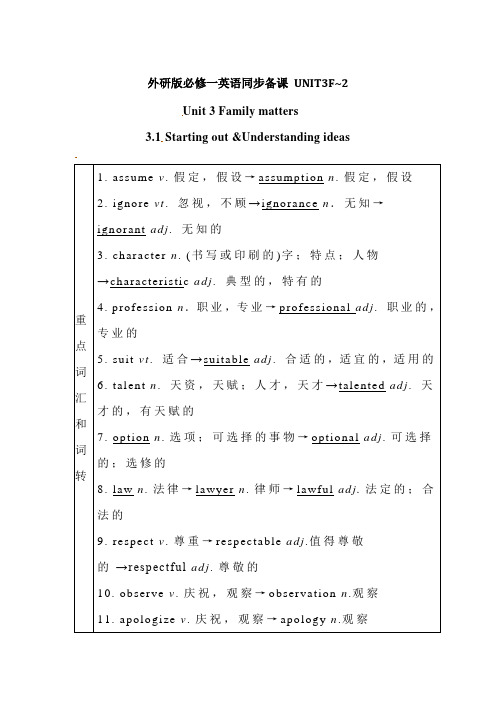
外研版必修一英语同步备课UNIT3F~2 Unit 3 Family matters3.1 Starting out &Understanding ideas知识点01重点词汇考点一:approach 靠近,接近,走近;临近;(vt)着手处理,对付=deal with(n):(在时间或距离上的)靠近,接近 (cn):方式,路径,道路+to/turn to:向...求助;把(注意力)转向;翻至(某一页)An approach to...:通往...的道路;...的方法With the approach of...随着...的来临/临近At the approach of...在...临近的时候Approach sb/sth:接近某人/某物辨析1.approach:指待人接物或思考问题的方法2.Way:常用词,处理任何事物的方法3.Means:指实现目的的手段:by means of doing sth by ...means4.Method:指合乎逻辑,科学系统的方法with a(n) method of...Manner:礼仪或怪异的行为例1.【单句填空】1.(北京四中期末) Due to the new approach,wheat production has risen over the years. 词性:含义:2.It might be possible to approach the problem in a different way.3.As I approached mile 23, I could see my wife waving a sign. She is my biggest fan.4.We discussed three different approaches the study of mathematics.5.They came up with several approaches to (solve) the problem, but some were not practical.考点二:Focus(v):集中;(使)调节焦距Focus (one’s attention/energy ) on ...= concentrate on= centre on~fix one’s attention /eyes/mind on....Be centred on...:集中在...Focus one’s eye on...:注视...The focus of attention:关注的焦点Bring ....into focus:使...成为焦点例2.【单句填空】1.The photographer told us to adjust the focus of our camera before we take photos.2.The teacher reminded Tom to focus his attention what she was saying. So all the students looked at him, he became the of the class.考点三:Respect(vt):尊重,尊敬;慎重对待;respect vt. 尊敬(for);遵守n. 尊敬,尊重;关心,考虑out of respect 出于尊敬show/have respect for: 尊重/尊敬某人/某物反意词组:look down on /upon “轻视/看不起”respectable adj. 受人尊敬的;相当好的respectably adv.相当地;得体地 respectably dressedrespectful adj. 恭敬的,表示尊敬的 listen in respectful silence respecting prep. (=concerning) 关于,至于respective adj. 分别的,各自的But in practice, few drivers respect the rules.He is a respectable teacher.We should have/show respect for the old.Respect sb(for sth):(因某事而)尊重/尊敬某人 be respectful to sbRespect sb as...:尊敬某人为... be respectful of sthHave/show (no)respect for...Gain/win/earn the respect of...Lose the respect of...Out of respect:出于尊重In respect of~with respect to...:关于...,就...而言In some respectsGive /send one’s respects to sb:代...问候某人例3.【单句填空】1.The Smiths are a couple and they are always of other people’s opinions.(respect)2.He didn’t give any opinions with respect this matter.3.Please send my (respect) to them when you write.4.For our future generations, we must show respect nature and increase the amount of waste we recycle.5.He is always ready to help those in trouble,so he wins the respect his classmates and his teachers.6.The headmaster of our school is a __________ old man.A. respectiveB. respectableC. respectfulD. respecting考点四:Suit(vt):适合,适宜;对...方便;和某人心意;相配,合身Suit sth to sth/sb:使适合或适应某物/某人Be(best/well/ideally/perfectly) suited for/to...:对...适宜,适合... Suit sb(fine):(很)和某人的意;对某人合适Be suitable for....:适合于... be unsuitable for...:不适合...Be suitable to do sth辨析Suit:侧重于符合某人的品味或服装的颜色,款式等相配或适合 Fit:合身,尺寸或形状合适,强调尺寸,大小或形状上的吻合 Match:与...相配/相称,多指两个物体在大小,色调,形状,性质等方面相配,显得很协调。
(完整版)英语组集体备课活动记录表

1、颜色、大小、长短等形容词。(水果呈现)
2、衣服名称
Stepቤተ መጻሕፍቲ ባይዱ3、学生完成课本1a
Step 4、呈现目标语言结构How much is it/ are they?(单数、复数区别)
Step 5、出示附有价钱标签的衣服图片。T: How much is the sweater?
S: It’s …(教师引导回答)
Step 6: listening practice. Finish 1b.
Step 7: pair work.(结对操练句型)
Step 8: Summary.
Step 9: Homework.
课后作业
活动反思
与意见
设计较好,重点在于课堂中如何把握,资源可以共用。
英语组集体备课活动记录表
项目名称
英语集体备课
负责人
王锦前
活动时间
2018-3-15
活动地点
英语办公室
活动主题
八年级Unit 7 how do you make a banana milk shake?集体备课
主备人
吴洁
参加对象
英语组全体成员
活动内容
简要
为响应学校的号召,开展校本培训,本教研组于11月15日进行了本学期集体备课活动。
活动反思
与意见
此次活动是一次教科研活动,也是一次经验交流和培训,通过集体的备课,让本节课尽善尽美,也在一定程度上提升了教师的专业素质,更体现了作为教师的本职。资源共用。
英语组集体备课活动记录表
项目名称
英语集体备课
负责人
王锦前
活动时间
2018-4-18
活动地点
大学思辨英语精读备课Unit3
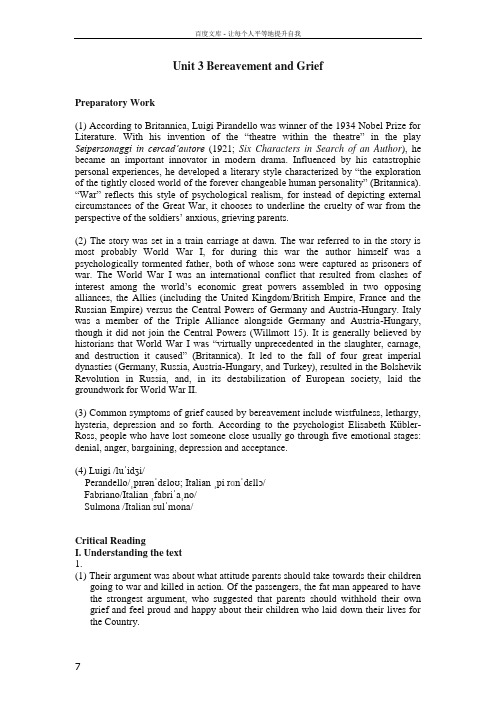
Unit 3 Bereavement and GriefPreparatory Work(1) According to Britannica, Luigi Pirandello was winner of the 1934 Nobel Prize for Literature. With his invention of the “theatre within the theatre” in the play Seipersonaggi in cercad’autore(1921; Six Characters in Search of an Author), he became an important innovator in modern drama. Influenced by his catastrophic personal experiences, he developed a literary style characterized by “the exploration of the tightly closed world of the forever changeabl e human personality” (Britannica). “War” reflects this style of psychological realism, for instead of depicting external circumstances of the Great War, it chooses to underline the cruelty of war from the perspective of the soldiers’ anxious, grieving pare nts.(2) The story was set in a train carriage at dawn. The war referred to in the story is most probably World War I, for during this war the author himself was a psychologically tormented father, both of whose sons were captured as prisoners of war. The World War I was an international conflict that resulted from clashes of interest among the world’s economic great powers assembled in two opposing alliances, the Allies (including the United Kingdom/British Empire, France and the Russian Empire) versus the Central Powers of Germany and Austria-Hungary. Italy was a member of the Triple Alliance alongside Germany and Austria-Hungary, though it did not join the Central Powers (Willmott 15). It is generally believed by historians that World War I was “virtuall y unprecedented in the slaughter, carnage, and destruction it caused” (Britannica). It led to the fall of four great imperial dynasties (Germany, Russia, Austria-Hungary, and Turkey), resulted in the Bolshevik Revolution in Russia, and, in its destabilization of European society, laid the groundwork for World War II.(3) Common symptoms of grief caused by bereavement include wistfulness, lethargy, hysteria, depression and so forth. According to the psychologist Elisabeth Kübler-Ross, people who have lost someone close usually go through five emotional stages: denial, anger, bargaining, depression and acceptance.(4) Luigi /luˈidʒi/Perandello/ˌpɪrənˈdɛloʊ; Italian ˌpi rɑnˈdɛllɔ/Fabriano/Italian ˌfabriˈaˌno/Sulmona /Italian sulˈmona/Critical ReadingI. Understanding the text1.(1) Their argument was about what attitude parents should take towards their childrengoing to war and killed in action. Of the passengers, the fat man appeared to have the strongest argument, who suggested that parents should withhold their own grief and feel proud and happy about their children who laid down their lives for the Country.(2) In Paragraphs 15 and 16, he is described as a “fat, red-faced man with blood-shoteyes of the palest gray”, who was “panting”, and “from [whose] bulging eyes seemed to spurt inner violence of an uncontrolled vitality which his weakened body could hardl y contain”. In Paragraph 17, it is revealed that his two front teeth are missing. His eyes are once again mentioned in Paragraph 29, described to be “bulging, horribly watery light grey”.These physical traits might suggest that the fat man was in poor health, and was grief-stricken by his son’s death.(3) The woman asked the question of the fat man because she was awed by his stoicresponse to his son’s death. She found it extremely diff icult to cope with her anxiety over her son’s departure for the front, and wished to confirm the fat man’s feelings so that she might derive some strength from his example. She was the one who asked the question, rather than one of the other passengers, because she,as a focalized character whose inner consciousness was explored at great length, was trying to emphasize with the fat man. The fat man reacted strongly to this question, stupefied, brought into painful awareness of his son’s death, and reduced to uncontrollable sobs. This reaction indicates that the fat man, instead of calmly accepting the fact of his son’s death as he claimed, had been desperately rejecting this horrible idea.2.(1) F(2) F(3) T(4) T3.(1) D(2) A(3) AII. Critiquing the Text(1) Instead of giving direct description of war action, the story depicts the emotionalturmoil on the part of the soldiers’ parents. The author intends to send a message about the cruelty of war, by showing that war imposes great suffering in more ways than one, not only on the soldiers who go to the battlefield, but also on their parents who are extremely worried about their safety and may have to endure the pain of loss.(2) The fat, red-faced man started his part of the argument by putting a stop to theother passengers’ debate over the correlation between the intensity of the parents’ anxiety and the number of children they have on the battlefield. He insisted that parents gave life to their children not for their own benefit, and that they should r espect their children’s wish to go to the front. He ended his argument by claiming that parents should accept their children’s death on the battlefield without grief, showing that he himself chose not to wear mourning for his son.His argument is inconsistent, for at first he mentions all the glamour of youthful life, including “girls, cigarettes, illusions, new ties”, but then he talks about dying “young and happy”, “without having the ugly sides of life, the boredom of it, the pettiness, the bitterness of disillusion”. The latter statement overlooks the good sides of life mentioned in the former one. His argument is also somewhat illogical, because the awareness that children do not belong to their parents does not necessarily lead to the conclusion that parents should not grieve over their children’s death. Therefore, the reason he gave for not grieving was unconvincing.His pause and hesitation in the middle of the sentence “Our sons are born because…well, because they must be born” might be seen as a rev elation of his checked impulse to articulate his paternal affection. It is as if he were to blurt out “Our sons are born because we love them”. He refrained from saying something like this probably for fear that he could not check his emotion once letting it out.(3) When he mentioned “girls, cigarettes, illusions, new ties”, he was referring to theelements of youthful life that were more alluring to young people than their parents’ affection. He was trying to say that young people had so much to enjoy that their lives would never be centered around their parents. His thoughts about being young can barely support his subsequent view that there should be no mourning for someone who died young and happy. On the contrary, the fact that young people have many good things in store for them makes their death all the more lamentable.(4)The fat man’s feeling for the “Country” was more likely to be a clichéconveniently used to advance his argument, for he used the “if” clause instead of stating it as a matter of course. This indicates his awareness that the Country being a natural necessity is merely a popular notion. However, there might be an element of sincerity in his feelings for the “Country”, as he repeatedly spoke of “decent boys” that chose to fight for their country. But on the whole, the notion of the Country might just be a convenient platitude to veil or suppress his bitterness about his son’s death.(5) The reasons offered by the fat man when he said a young man could die happywere poorly grounded and hardly convincing. He was indeed trying to rationalize the death of his son, so as to assuage his pain of bereavement, but the rationalization was too fragile to be of any comfort to him. The son might have mixed feelings about his father’s words. On the one hand, he might be able to understand his father’s inner struggle, but on the other, he might feel uncomfortable about his father saying he died satisfied.(6) The question is considered “silly” and “incongruous” from the passengers’ pointof view. In the eyes of other passengers, the fat man already made his point clearly, and the woman appeared absent-minded. Her question was considered silly because the answer was already evident. And it would seem incongruous with the whole atmosphere. While other passengers were voicing their agreement with the fat man, the woman’s question was abrupt and unexpected.This point of view has an emotional effect th at reinforces the fat man’s loneliness.He had to battle with his emotional turmoil all on his own, with all the other people believing he was coping really well.(7) All these four definitions are common denotations of the word patriotism, which isa controversial notion. It is morally valuable, for it can arouse noble sentiments ofheroism within people and unite them together as a whole nation. But whether it should be mandatory is disputable, for it may be pushed to an extreme and require people to sa crifice their personal interest for the “greater good” that might sometimes be questionable.(8) One possible version:January 1st, 1918 Dear Father,I wish you and Mother a happy new year. Perhaps you’re in no mood for celebrations for it has been almost three years since we celebrated the new year together as a family. I am in no festive mood either. The campsite here is cold and dreary, and is permeated with an atmosphere of mourning. I myself was lucky enough to survive the horrible battle in Caporetto, but hundreds of thousands of my comrades lost their lives in it. This is a nightmarish new year for me.Several years ago, I thought it a glorious thing to go to war in defense of our country. I would become a national hero if I fought valiantly. And now, I’ve come to realize that war is seldom about heroism; it is nothing but a massacre of innocent lives.I knew little about the enemies we killed, but I did know that some time before they had been allies with us. It is most likely that they, just like us, are innocent, naïve young people with an enthusiasm for heroic action.I used to say it would be a bliss to lay down my life for the Country. I still think so, but for a different reason. I never know when exactly I will get killed, but to be killed instantly is so much better than to take a bullet that cripples me for life, to get my face burnt beyond recognition, or to suffer any other kind of serious wounds with lifelong aftermaths. Such disasters happen to my comrades every single day, and I can only pray that they do not fall upon me. So, if I get killed someday, I will die satisfied at having ended my life in the best way I could wish.Remember me to all our friends back home, and do not wear mourning if I can never come back again.Your loving sonLanguage Enhancement5.(1) Pirandello employs the linear structure in the story, and develops the plot mostlythrough conversation. He includes so much conversation probably because he intends to “show more than tell”, to have the characters voice their own opinions instead of speaking for them himself. In this way, he can present a variety of clashing views and characterize each individual more effectively. The author’s narrative style can be characterized as internal focalization that places the woman at the center of consciousness. He describes the woman’s feelings and thoughts in great detail, while characterizing other passengers through external depictions. (2) The words that describe feelings and emotions include “sad” (Paragraph 6), “indistress” (Paragraph 18), “deep sorrow” (Paragraph 24), “harrowing, heart-breaking, uncontrollable sobs” (Paragraph 24), etc. Besides the use of adjectives, Pirandello builds up emotional intensity by delineating the gloomy setting (“stuffy and smoky second-class carriage” in Paragraph 2). Also, he does so by describing each character’s gestures and facial expressions. For example, the woman is portrayed as a pitiful sight, “twisting and wriggling, at times growling like a wild animal” (Paragraph 8), and the fat man “shook his light fawn coat” as to show he did not wear mourning, and “his livid lip over his missing teeth was trembling, h is eyes were watery and motionless, and soon after he ended with a shrill laugh which might well have been a sob” (Paragraph 22).Intercultural Reflection1. Grief is doubtless the dominant emotion in both Western and Chinese memorial services. Interestingly however, there is a difference as to whether grief is required to be displayed in public. In China, at least in the past, public demonstration of grief was considered mandatory for those in bereavement, especially for those who lost their spouses, parents or masters. There might even be professional mourners hired to weep funerals (take Grandfather Gao’s funeral in Ba Jin’s Family for example). It is extremely unorthodox behavior to replace heart-rending weeping with light-hearted rituals. Chuang-tzu’s affection for his wife was questioned when he played at a basin and sung after her death. RuanJi deliberately chose to conceal his grief and feast in front of mourners at his father’s funeral, an act that was considered eccentric. In the West, it is not a strict moral obligation to weep at funerals of one’s close relations. Upon Old Earnshaw’s death in Wuthering Heights, for example, each member of the younger generation had their own way of processing grief.Tomb-visiting is a common way to pay respects to the deceased both in China and the West. For example, Oskar Schindler’s grave was visited by the Jews whose lives he had saved. In “Thoughts on a Visit to an Ancient Battlefield”, Li Hua depicted scenes in which the dead soldiers’ families placed offerings and poured wine over imaginary graves while contemplating the distant horizon in tears (“布奠倾觞,哭望天涯”). There is a difference between these two mourning rituals, though. The Schindler Jews were to commemorate their deceased benefactor, while the dead soldiers’ families in Tang Dynasty wished to guarantee the well-being of the deceased in the underworld (“吊祭不至,精魂何依”). Tomb-visiting is also an effective way to cope with one’s own emotional problems, for the deceased can be regarded as an omniscient, non-judgmental listener. Zhang Wuji, hero of Jin Yong’s Heaven Sword and Dragon Saber, visited his parents’ grave after a severe fault in his decision-making. Christine Daye in The Phantom of the Opera also went to her father’s cemetery to assuage her emotional turmoil.Both Chinese and Western mourning customs would impose restrictions on entertainment. In The Dream of the Red Chamber, the domestic theatrical troupe of the Jia household was dismissed when an elder concubine passed away. In Gone with the Wind, Scarlet O’Hara was prohibited from wearing colorful clothing and dancing in public after her husband’s death, which was suffocat ing for her. This tradition is passed down to the modern era, though not as rigorous as before. After Wenchuan earthquake, for example, entertainment activities were suspended for three days in mourning for the deceased victims.2. 元缜《遣悲怀(其一)》谢公最小偏怜女,自嫁黔娄百事乖。
陕西省石泉县池河中学人教版英语九年级第三单元集体备课

二、话题思维导图
Amusement park, bookstore, flower store, supermarket, mall, library, museum, restroom, restaurant, subway Getting around Pubic places Big, interesting, clean, fascinating, Quiet, uncrowded, beautiful, safe, convenient
池河中学单元(章节)集体备课记录表
九年 年级 级
中心发言人 刘子艳 李翠萍 蒋杰
科目
英语
时间
201 5 年 9 月 21 日(第四 周)
标题
Unit 3
成员
本单元话题为得体礼貌地运用语言索取信息及提供信息。Section A 以购物和 去游乐园游玩等日常生活为切入口, 通过问路及指路引入语言操练及学习, 让学生 通过模拟日常真实场景体会、 感受及领悟目标语言内容。 这一阶段教学结束时学生 应当重点掌握并能够熟练、正确运用的内容包括: 1、功能及句型结构方面: (1)得体地运用礼貌语句问路及咨询信息,例如: Excuse me ,do you know where I can buy……?Could you please tell me how to get to ……?Can you tell me when……?I wonder where we should……; (2)礼貌、得体地指路及提供信息,如:Sure. There’s a supermarket down the street .或得体地进行否定回答:Sorry, I’m not sure how get there. 2、词汇方面:教材所呈现的有关日常生活活动短语(如 get some money ,buy some stamps 等)和相关处所名词(如 bookstore, restroom 等) ,以及与问路、 指路及询问、提供信息相关的短语等; 3、语法方面:带有 wh-疑问结构的宾语从句。 从编写特征和相关语言内容来看,活动 la-lc 在语境中复现和呈现动词短语, 侧重 get,buy 等动词引起的日常生活活动短语, 同时呈现本单元重点句型结构。 教 师应注意利用书本主题图等媒介加强语境设置,为学生模拟日常生活情景进行问 一、 路、指路创设条件;活动 2a-2d 通过听说活动将相关语言知识和听说技能相结合, 教材 加强综合性语言输入;活动本单元语法为含有 wh-疑问词的宾语从句,此结构强烈 因此在开展 分析 表现出语言的功能特征——礼貌地在公共场合索取信息时的语言结构。 本单元语法教学时, 建议教师一要想办法让学生意识到礼貌语文结构特征; 二要帮 助学生突破含有 Wh-疑问词宾语从句的难点(易错点) 。 在实际语言运用中, 人们往往将这些句型视为一个整体进行记忆和运用, 若教 师在教学中注意关注这一特征, 并得当地引导学生有意识地对它们进行整体识记和 运用,可有效降低学生语言运用的错误率,也使相关内容变得轻松易学。 从相关的训练活动上看,4a 主旨在于训练学生宾主从句的造句能力,关注语 言结构;4b 给出不同的情境,让学生运用宾语从句礼貌地询问信息:4c 则更加突 出本单元语法内容的交际性运用, 使学生通过语言交流活动运用、 内化相关语言知 识。 在含有 Wh-疑问词的宾语从句方面,我国学生较多地存在语序方面的错误,表 现为在从句部分仍然使用倒装的疑问结构。 教师可继续采用一单元建议的对比主语 法,即将某一特殊疑问句与含有该问题的宾语从句利用板书或媒体课件成对呈现, 让学生观察对比、探究异同,教师归纳总结。同样教师还可以结合具体学情,在完 成书本练习的基础上补充一定量的相关语句进行操练,以达到熟练及巩固的目的。 这一部分主题仍为 section A 部分的继续,但侧重点有所不同。从语言层面上 看, 这一部分突出帮助学生扩充自己的描述性词汇语库, 训练他们运用形容词描述
四年级上册英语集体备课

1.掌握She/He has…的用法。
2.能表演Let’s talk的对话。
教学难点
能运用所学的句型描述自己的朋友。
教学过程
1.Sing a song: friends
2.Read the words
tall and strong,
short and thin,
friendly,quiet
教学过程
She has……Her……are…
8. Listen the third time and imitate
9.分角色读对话
10.Let’s play
1)教师用课件呈现句型:
He/She is…
He/she has….
His/Her shoes are…
His/Her bag is…
What is his/her name?
2.听、说、认读句子My friend has blue glasses. It’s Wu Yifan. His glasses are blue.
3.能完成Say and draw.
教学重点
听、说、认读短语long hair short hair a green bag blue glasses brown shoes
1. 教师出示单词卡,复习1-3单元所学单词。
2. 做游戏Listen and do.
教师把图片摆放在讲台桌上,让一个学生到讲台桌前看图发布命令,另一个学生根据他的命令来做动作。复习第一单元A,第二单元A, 第三单元B的Let’s do 部分。
(二)呈现新课 (Presentation)
1. Free talk. 教师与学生就有关教室、学习用品、朋友的话题做问答练习。
冀教版三年级英语上册集体备课教学课件Unit3 第三单元PPT
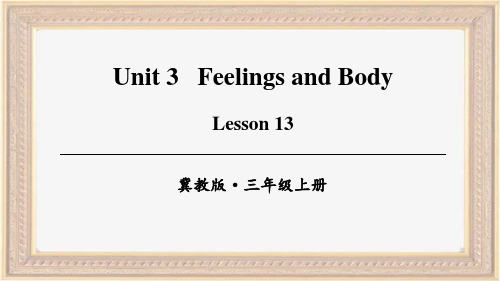
body
head
arm
hand
leg
foot
Language points
What is it? 它是什么? 这是由what引导的一个特殊疑问句,用来询问某
物是什么。 句型结构:疑问词+be动词+人/物? 有时我们也用“What is this?/ What is that?(这
是什么?/那是什么?)”来询问,其答语是“It’s a/an+可数名词的单数形式(它是一个……)”。
How do you feel? I feel ____s_a_d____.
How do you feel? I feel __h_a_p__p_y___.
Language points
1. How do you feel? 你感觉怎么样? 这是一个由how引导的特殊疑问句,用来询问
对方的感觉。 例句:—你感觉怎么样?—我感觉很高兴! How do you feel? I feel happy.
拓展:当主语是第三人称单数时,助动词do要 变为第三人称单数形式does。
例句:—汤姆感觉怎么样?How does Tom feel? —他感觉很累。He feels tired.
2. I feel happy, too! 我也感觉很高兴! (1)当表述自己的某种感受时,可以使用句型:
I/We feel +表示感觉的形容词,用来表达感觉。 例句:我感觉很冷。 I feel cold.
This is warm.
Activity
This is __w_a_r_m____.
This is ___c_o_o_l___.
This is ___co_l_d____.
陕旅版英语四年级上册集体备课第三单元

----No,we don't./Very little.
情感目标:
一、通过本课的学习,教育学生珍惜食物, 养成不浪费的好习惯。
二、引导学生养成健康的饮食习惯。 三、让学生了解中西方饮食的差异。 四、鼓励学生喝他人进行小组合作,培养学 生的合作能力。
2)Play a guessing game.
3)完成Part C: Listen and circle. 4)连线 lunch rice noodles dumplings, Breakfast
本单元作业要求:
本单元单词单词五遍带一遍汉语意思。
教学目标: 1.学习掌握以下句型: ___What's for breakfast/lunch? ___We/I have...for breakfast/lunch. 2.能在日常生活交流中正确运用上述功能句型。 3.通过实际练习,提高学生的综合语言运用能力。
单元具体目标:
知识目标:
一、能听、说、读、写有关一日三餐的单词 lunch ,breakfast,rice ,soup ,noodles ,dumpling s ,meat, Chicken.:
二、能听懂、会说、会读、下列句型 : 1.----What’s for breakfast/lunch/dinner?
本单元作业要求:
本单元单词结合以下句型的练习: 1.—Dinner/Lunch...is ready! 2. — What's for dinner?
3. —Do you have...?
九年级英语集体备课记录表内容
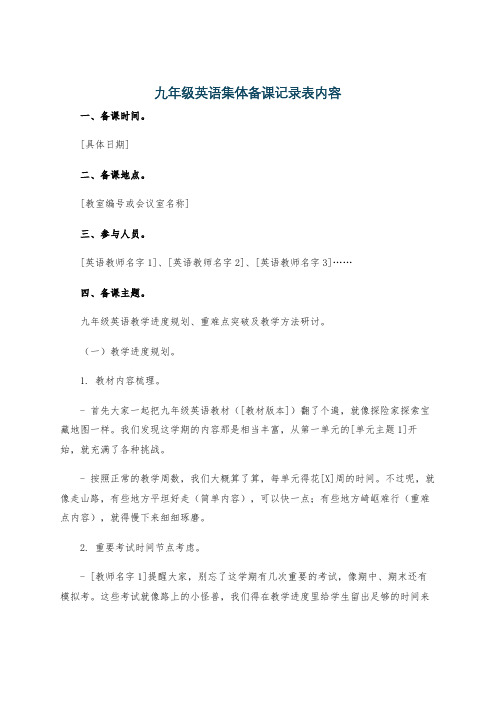
九年级英语集体备课记录表内容一、备课时间。
[具体日期]二、备课地点。
[教室编号或会议室名称]三、参与人员。
[英语教师名字1]、[英语教师名字2]、[英语教师名字3]……四、备课主题。
九年级英语教学进度规划、重难点突破及教学方法研讨。
(一)教学进度规划。
1. 教材内容梳理。
- 首先大家一起把九年级英语教材([教材版本])翻了个遍,就像探险家探索宝藏地图一样。
我们发现这学期的内容那是相当丰富,从第一单元的[单元主题1]开始,就充满了各种挑战。
- 按照正常的教学周数,我们大概算了算,每单元得花[X]周的时间。
不过呢,就像走山路,有些地方平坦好走(简单内容),可以快一点;有些地方崎岖难行(重难点内容),就得慢下来细细琢磨。
2. 重要考试时间节点考虑。
- [教师名字1]提醒大家,别忘了这学期有几次重要的考试,像期中、期末还有模拟考。
这些考试就像路上的小怪兽,我们得在教学进度里给学生留出足够的时间来准备战斗。
所以在[具体日期]之前,我们得完成[某个单元]的教学,这样才能有充裕的复习时间。
(二)重难点突破。
1. 语法重难点。
- 定语从句。
- [教师名字2]皱着眉头说:“这个定语从句啊,就像一团乱麻,学生们总是搞不清楚先行词和关系词的关系。
”大家纷纷点头,感觉这是个“硬骨头”。
- 经过一番热烈讨论,我们决定采用“故事法”来讲解。
比如说,“I have a book which is very interesting.”就可以把“book”当成主角,“which is very interesting”当成是描述这个主角的一个小跟班(定语从句),这样形象的比喻或许能让学生更好理解。
- 被动语态。
- [教师名字3]表示:“被动语态也是个老大难,学生们经常忘记be动词的变化。
”- 我们商量出一个“口诀法”:“被动语态be字变,过去分词后面添。
”并且打算多找一些有趣的例句,像“Many trees are planted by students every year.”让学生通过大量的实例来加深记忆。
2023外研社小学英语课件(一起点)备课卡M3U2 新授
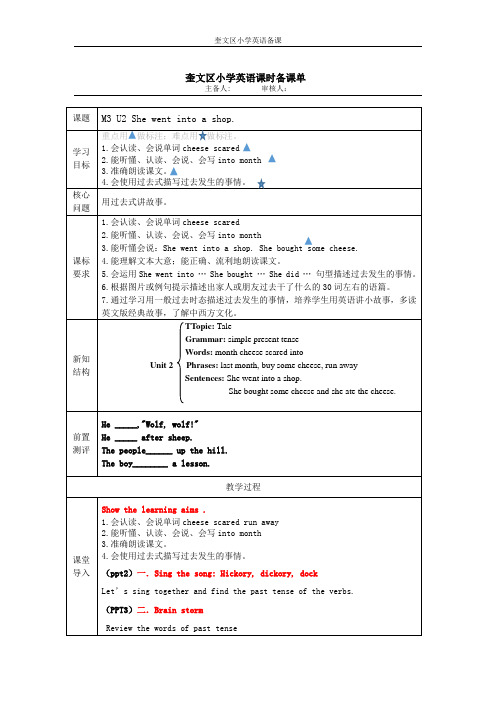
Sentences:She went into a shop.
She bought some cheese and she ate the cheese.
前置测评
He _____,"Wolf, wolf!"
选做:2.Prepare a story about you or your families。Show us next class.
B:给出正确的关键词
A:能用过去式根据图片内容讲故事
达标测试
(基于目标)
学习成果(思维导图、文字呈现、绘画、测试题……)
完成练习三的故事
Now work with a partner.Write down the story in practice 3.
(根据所给关键词完成小故事的讲述)
3.Writeitdown
4.Teaching methods:
a.观察图片,然学生尽可能多的给出与图片相关的单词。
b.用学生所给的单词,完成每一幅图的句子。然后老师带领学生尝试用英文讲述这个故事。
c.学生展示或说出故事。
五.Summary and homework
3.准确朗读课文。
4.会使用过去式描写过去发生的事情。
(ppt2)一.Sing the song: Hickory, dickory, dock
Let’s sing together and find the past tense of the verbs.
(PPT3)二.Brain storm
Review the words of past tense
六年级英语组集体备课活动记录表(三)

Lesson 6 Let’s check Let’s wrap it up story time
教学
建议
创设真实的语言环境,采取小组竞赛等方式进行有效教学。
小组
成员
讨论
意见
xxx:三单元的主题与旅游有关,建议在教学时,要求学生准备好自己旅游的照片,并用学过的英语描述这次旅游;同时将照片传给老师,老师制成PPT,在学完这个单元后,进行“旅游交流会“。
重点
难点
一般过去时的构成结构极不规则动词的过去式。
课时
安排
Lesson 1 A Let’s learn & Do a survey and report
Lesson 2 A Let’s talk Let’s try
Lesson 3 B Let’s try Let’s talk
Lesson 4 B Let’s learn
xxx:根据小学生学习的特点,小学英语教学要创建活动课为主的教学模式,教学重点是培养学生用语言进行交流的能力。小学英语教学不讲解语法概念。要充分利用教学资源,采用听、做、说、唱、玩、演的方式,鼓励学生积极参与、大胆表达,侧重提高小学生对语言的感受和初步用英语进行听、说、唱、演的能力。小学六年级的英语教学,在进一步加强学生听说能力的同时,发展初步的读写能力,为进一步学习打好。
单元
教学
目标
1、学习询问他人生活状况的问句并学习用一般过去时的句型询问对方的旅行。
2、掌握四会单词或词组。
3、能听说认读单词或者短语。
4、会唱歌曲《Tell me about your holiday》。
5、通过讲述路途见闻,培养学生合理安排学习பைடு நூலகம்生活的能力,激发学生热爱大自然的美好情感,培养学生乐于与他人交往的性格。
译林版五年级上册英语unit3教案5篇

译林版五年级上册英语unit3教案5篇在教学中,谨慎备课,谨慎阅读各种教科参考书,结合自己的教学经历与学生的学习状况,谨慎编写好教案制定好教学打算,并不断地加以改善修改。
在传授学生学问的同时,关怀爱惜学生。
以下是我带来的译林版五年级上册英语unit3教案内容,感谢您的阅读,盼望能协助到您!译林版五年级上册英语unit3教案1教学目标:1、在老师的引导下复习动词过去式的改变规那么2、学习用do的过去式did引起的一般疑问句及其应答。
3、熟读课文,并会进展对话。
教学重点:学习用do的过去式did引起的一般疑问句及其应答。
教学难点:熟读句子,并会进展对话。
教学过程:一、老师带着学生复习动词过去式的改变规那么二、学生自学1、学生自由读listen and say 栏目的句子,了解句子的汉语意思。
2、播放录音,学生看书听录音。
3、再放录音,学生边听边跟读。
4、学生自由朗读课文。
三、合作探究1、老师示范朗读句子。
2、学生结对练习对话。
3、请个别学生上前表演对话。
4、在小组内探讨do 和did的用法有什么不同,老师作必要的指导。
四、学生展示老师将本节课所学的重点句型出示再黑板上,学生对重点句型进展操练并展示。
板书设计:Unit2 different noisesDid you like ... ?Yes. I did.No. I didn’t译林版五年级上册英语unit3教案2Lesson 1一.教学内容Main scene Part A (let’s try let’s talk)二.教学目标1.能正确听,说,朗读“Who is ...?-- He/She is...What’s he/she like? -- He/She is...Is he/she…?--Yes,he/she is. No, he/she isn’t.”2.能正确听,说,认读表示人物外貌与性格特征的形容词old,young,funny,kind,strict,polite,hard-working,clever.3.能听懂,会说,会表演Let’s talk 的内容并在真实场景中运用。
《Unit 3 What would you like》集体备课表6
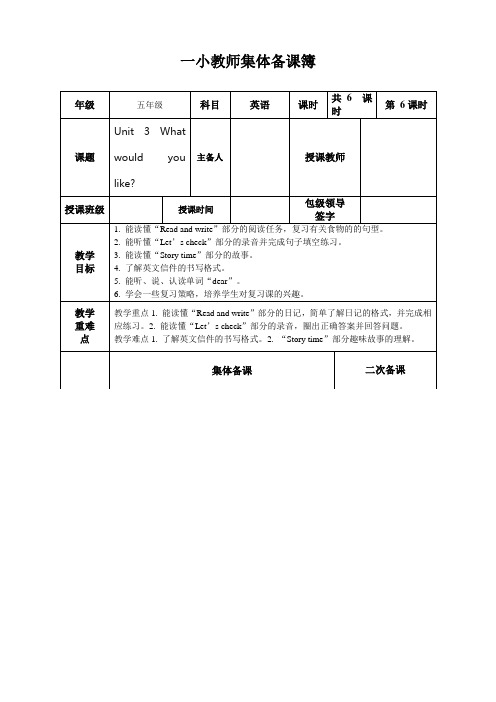
①What’s Wu Yifan’s favourite food?
②Does Wu Yifan like beef?
③What’s Grandpa’s favourite food?
(5) Write to Robin and tell what you would like to eat.
A. Let B. Let’s C. Lets
五、课堂小结(Summary)
师生一起总结本单元学习的词汇和句型。
六、布置作业(Homework)
1.听录音,跟读本单元的内容一次。
2.预习下一单元的内容。
板
书
设
计
教
学
反
思
一小教师集体备课簿
年级
五年级
科目
英语
课时
共6课时
第6课时
课题
Unit 3 What would you like?
主备人
授课教师
授课班级
授课时间
包级领导
签字
教学
目标
1.能读懂“Read and write”部分的阅读任务,复习有关食物的的句型。
2.能听懂“Let’s check”部分的录音并完成句子填空练习。
(2)先让学生观察图片中的食物,然后播放教学录音,学生根据录音内容完成句子填空。
四、巩固延伸(Consolidation & Extension)
1. C. Story time
(1)教师用多媒体课件出示本部分的教学挂图,学生猜测故事大致内容。
(2)介绍故事背景。
T: Zoom and Zip are at the farm now. Zoom is hungry. They’ll cook by themselves. Let’s listen to the tape and see what happens.
英语集体备课记录
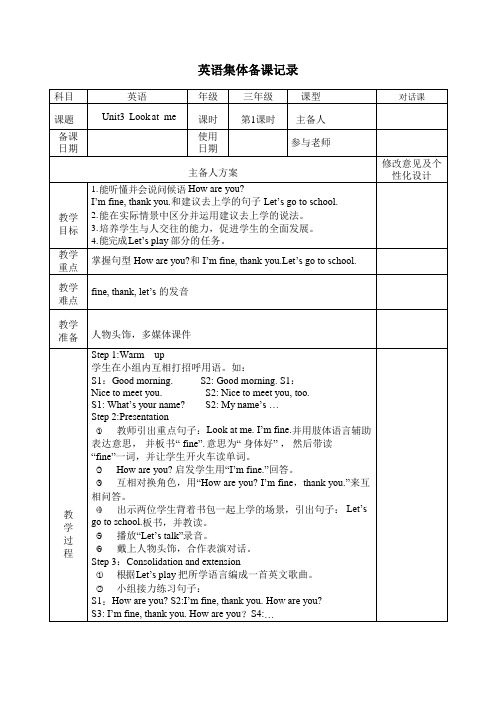
英语集体备课记录Step 1:Warm up学生在小组内互相打招呼用语。
如:S1:Good morning. S2: Good morning. S1:Nice to meet you. S2: Nice to meet you, too.S1: What’s your name? S2: My name’s…Step 2:Presentation(1)教师引出重点句子:Look at me. I’m fine.并用肢体语言辅助表达意思,并板书“ fine”. 意思为“ 身体好” ,然后带读“fine”一词,并让学生开火车读单词。
(2)How are you? 启发学生用“I’m fine.”回答。
(3)互相对换角色,用“How are you? I’m fine,thank you.”来互相问答。
(4)出示两位学生背着书包一起上学的场景,引出句子:Let’s go to school.板书,并教读。
(5)播放“Let’s talk”录音。
(6)戴上人物头饰,合作表演对话。
Step 3:Consolidation and extension(1)根据Let’s play 把所学语言编成一首英文歌曲。
(2)小组接力练习句子:S1:How are you? S2:I’m fine, thank you. How are you?S3: I’m fine, thank you. How are you S4:…Unit 2 Ways to go to schoolB let’s learn, Role-play教学设计一、教学内容:学习内容是Grade 6 Unit 2 Ways to go to school B let’s learn, Role-play二、教学目标:(1)学生能够听、说、读、写 traffic lights, wait, slow down, go;能够熟练运用句型…must…提出建议。
四年级最新版pep下英语三单元备课
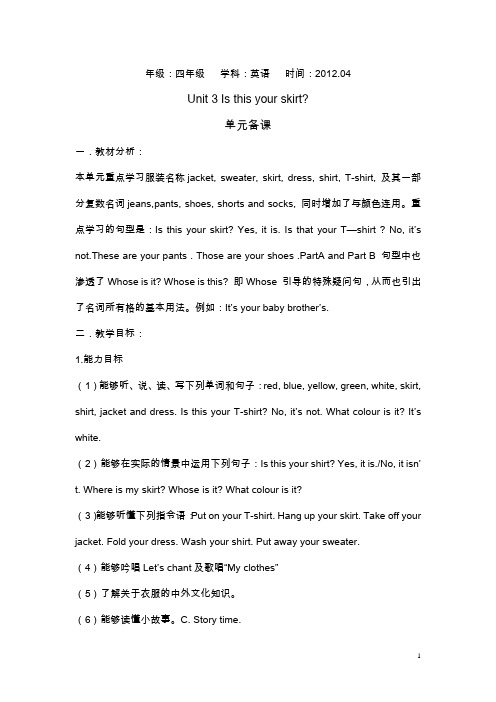
年级:四年级学科:英语时间:2012.04Unit 3 Is this your skirt?单元备课一.教材分析:本单元重点学习服装名称jacket, sweater, skirt, dress, shirt, T-shirt, 及其一部分复数名词jeans,pants, shoes, shorts and socks, 同时增加了与颜色连用。
重点学习的句型是:Is this your skirt? Yes, it is. Is that your T—shirt ? No, it’s not.These are your pants . Those are your shoes .PartA and Part B 句型中也渗透了Whose is it? Whose is this? 即Whose 引导的特殊疑问句,从而也引出了名词所有格的基本用法。
例如:It’s your baby brother’s.二.教学目标:1.能力目标(1)能够听、说、读、写下列单词和句子:red, blue, yellow, green, white, skirt, shirt, jacket and dress. Is this your T-shirt? No, it’s not. What colour is it? It’s white.(2)能够在实际的情景中运用下列句子:Is this your shirt? Yes, it is./No, it isn’t. Where is my skirt? Whose is it? What colour is it?(3)能够听懂下列指令语:Put on your T-shirt. Hang up your skirt. Take off your jacket. Fold your dress. Wash your shirt. Put away your sweater. (4)能够吟唱Let’s chant及歌唱“My clothes”(5)了解关于衣服的中外文化知识。
人教版九年级英语 Unit3 优质课教案(全)
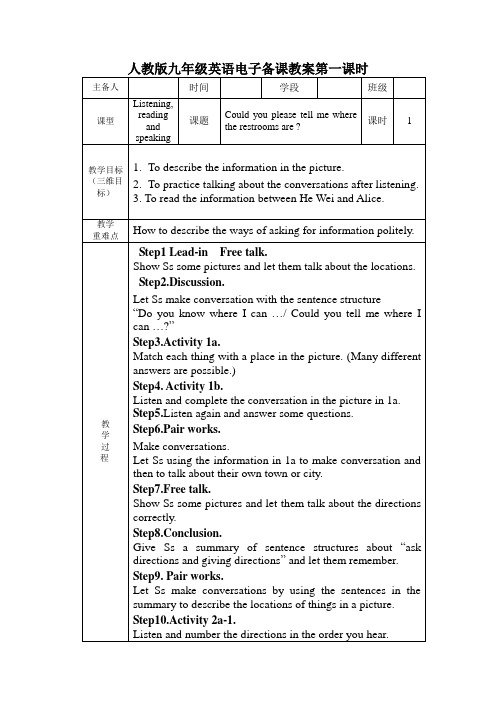
Step7.Free talk.
Show Ss some pictures and let them talk about the directions correctly.
nguage points:
explain the key words and phrases in section A-2
教学
反思
人教版九年级英语电子备课教案第三课时
时间
学段
班级
课型
Gou tell me where the restroom are ?
—Sorry,I’m not sure how to get there.
3.Iwonder where we should go next.
—You should try that new ride over there.
4.Could you tell us when the band starts playing this evening?
Step7.More exercises.
1.Choosing the right answers.
plete sentences.
3.Exchanges of sentence structures.
The exercises of Secondary School Entrance Exams
Step8.Conclusion.
Give Ss a summary ofsentencestructures about“ask directions and giving directions”and let them remember.
小学五年级英语第三单元备课教案4篇
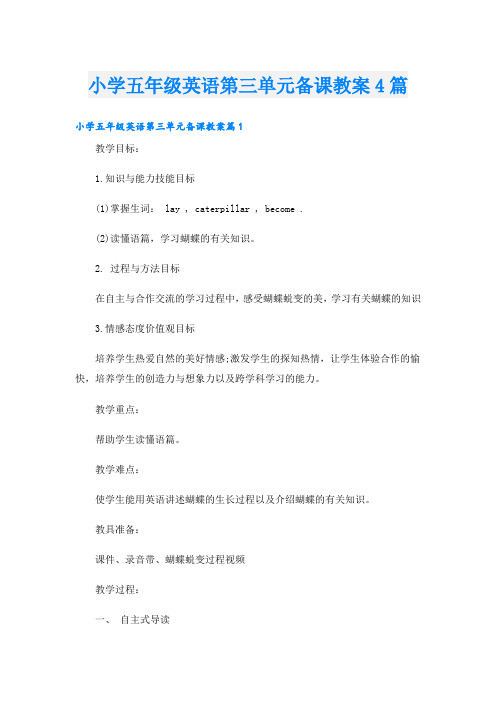
小学五年级英语第三单元备课教案4篇小学五年级英语第三单元备课教案篇1教学目标:1.知识与能力技能目标(1)掌握生词: lay , caterpillar , become .(2)读懂语篇,学习蝴蝶的有关知识。
2. 过程与方法目标在自主与合作交流的学习过程中,感受蝴蝶蜕变的美,学习有关蝴蝶的知识3.情感态度价值观目标培养学生热爱自然的美好情感;激发学生的探知热情,让学生体验合作的愉快,培养学生的创造力与想象力以及跨学科学习的能力。
教学重点:帮助学生读懂语篇。
教学难点:使学生能用英语讲述蝴蝶的生长过程以及介绍蝴蝶的有关知识。
教具准备:课件、录音带、蝴蝶蜕变过程视频教学过程:一、自主式导读Warming up:T: Nice to meet you ! Do you like insects ? Whichinsect do you know?Ss: ants, ladybirds, flies, butterflies…T: Among all the insects, which one is the most beautiful?S1: Butterflies.T: Yes , butterflies are one of the most beautiful insect in the world.I have some pictures about butterflies . Do you want to have a look ?In this lesson we are going to talk about butterflies.板书课题Module4Unit2 Butterflies(学生齐读课题)出示学习目标:(齐读学习目标,明确本节课的学习目的)1、我能听所读写单词: lay , caterpillar ,become .2、我能读懂语篇,学习蝴蝶的有关知识。
T: Do you known how about a butterfly grows ?Let’s watch a video together !Ss: Ok !T: It’s so magical !Do you want to talk about it by yourself ?Ss: Yes .T: You shoud rely the teaching outline to learn the text .导学提纲Where does a butterfly lay eggs?How are the eggs?What do the eggs become?What do they eat?What does this big and fat caterpillar make?What colour is it?It opens, what comes out? How about it ?What makes it dry?学生自学通过导学提纲的引领认真阅读文本内容,将导学提纲中出现的问题及生词勾画出来。
《Unit 3 What would you like》集体备课表4

1. B. Let’s try
(1)明确听力任务
(2)第一次播放教学录音,学生根据录音内容连线。
五、课堂小结(Summary)
小结本课的重要句型并对学生的饮食习惯进行必要的引导。
T: When you like something, you can say…
2.教师随机出示上节课学习的五个单词的词卡,全班学生表演相应的动作。
二、课前预习(Preview)
猜一猜
教师请两三位学生上讲台,写出自己最喜欢的食物,其他学生猜一猜,如:
T: Guess! What’s her / his favourite food?
Ss: Ice cream?
T: No, guess again.
Ss: Salad?
T: Yes, you’re right.
三、新课呈现(Presentation)
1. B. Let’s talk
(1)教师在黑板上画出自己喜欢吃的几种食物,说:“Look! There is ice cream, hamburgers, bread and noodles on the blackboard. They are food. They are my favourite food.”,教师边说边在黑板上画几个笑脸,帮助学生理解“favourtite food”的意思。
(2)介绍对话情景。
T: Sarah and Zhang Peng are talking about today’s menu. Let’s go and see what they would like to eat today.
(3)教师出示本部分的教学挂图,问:“What food and drink are in today’s menu?”,学生根据情景图回答:“There are noodles, beef, fish, sandwich, tomato soup and milk in today’s menu.”。
(第3周)四年级上册英语同步备课 Unit 3 Welcome to my house
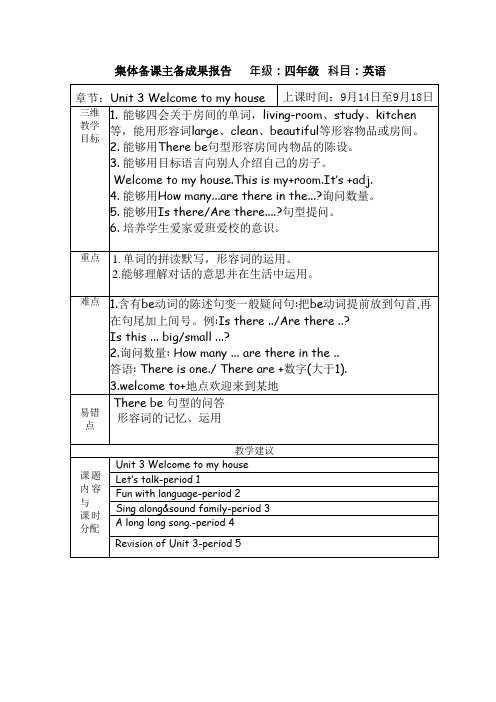
3.welcometo+地点欢迎来到某地
易错点
There be句型的问答
形容词的记忆、运用
教学建议
课题内容与课时分配
Unit 3 Welcome to my house
Let’s talk-period 1
Fun with language-period 2
重点
1.单词的拼读默写,形容词的运用。
2.能够理解对话的意思并在生活中运用。
难点
1.含有be动词的陈述句变一般疑问句:把be动词提前放到句首,再在句尾加上间号。例:Is there ../Are there ..?
Is this ... big/small ...?
2.询问数量: How many ... are there in the ..
This is the bedroom where I sleep.
This is the kitchen where I eat.
This is the garden where I play.
This is the study where I read.
This is the bathroom where I wash.
课时4教学要点
A long long song.(Period4)
一.Warm-up
1.Sing and act:This is my house.
2.Free talk
What do you like to do after class?
Do you enjoy singing/drawing...?
4.Let’s talk.(Tim&Tom)
四上集体备课记录表英语第三单元课标要求

四上集体备课记录表英语第三单元课标要求
一、课标要求
1. 语言知识
- 掌握第三单元的核心词汇和短语,如“家庭成员”、“职业”、“学校活动”等。
- 掌握基本句型,如“What does your father do?”、“He is a doctor.”、“We had a school trip last week.等。
- 掌握时态:一般现在时(第三人称单数形式)。
- 掌握基本语法:动词的第三人称单数形式、名词复数形式等。
2. 语言技能
- 听:能够听懂与单元主题相关的对话和短文,理解其大意。
- 说:能够运用本单元所学词汇和句型进行简单的口头表达,如介绍家庭成员、描述学校活动等。
- 读:能够阅读与单元主题相关的短文,理解其内容。
- 写:能够运用所学语法和句型,写出简单的英语短文,如日记、信件等。
3. 学习策略
- 自主学习:通过本单元的学习,学生能够自主总结归纳所学知识,形成自己的知识体系。
- 合作学习:通过小组讨论、角色扮演等活动,学生能够与他人合作完成任务,提高合作意识和沟通能力。
- 探究学习:通过观察、分析、归纳等活动,学生能够发现语言的规律和特点,提高探究能力和创新能力。
二、教学建议
1. 注重情景教学,结合实际生活,帮助学生理解和运用所学知识。
2. 加强听力训练,提高学生的听力水平。
3. 注重口语表达能力的培养,鼓励学生多说多练。
4. 加强阅读训练,提高学生的阅读理解能力。
5. 注重写作训练,提高学生的写作水平。
- 1、下载文档前请自行甄别文档内容的完整性,平台不提供额外的编辑、内容补充、找答案等附加服务。
- 2、"仅部分预览"的文档,不可在线预览部分如存在完整性等问题,可反馈申请退款(可完整预览的文档不适用该条件!)。
- 3、如文档侵犯您的权益,请联系客服反馈,我们会尽快为您处理(人工客服工作时间:9:00-18:30)。
中和路小学教学设计
学科:English 年级:three 月日课题Unit3 Look at me PartA Letters and sounds 主备人
教
材
简
析
学习目标1.能听、说、认读26个字母的大小写。
2.能听、说、读、写字母Ee,Ff,Gg,Hh,Ii。
3.能基本掌握字母Ee,Ff,Gg,Hh,Ii在不同单词中的发音,能认读相关例词。
教学重点难点重点:能正确书写字母Ee,Ff,Gg,Hh,Ii。
难点:掌握字母在不同单词中的发音。
课前准备教学光盘、教学道具、教学挂图、教学课件课时
安排
3
板书设计
Step 1:Warm up
(1)教师发指令,学生做相应的动作,做错的唱ABC song。
T:Close your eyes. Open your mouth. Touch your nose/ear/face.
(2)教师播放“ABC song”,学生跟唱,并分男女生组比赛歌唱。
Step 2:Presentation
(1)教师出示大象鼻子顶着鸡蛋的教学挂图,并利用教学课件出示单词:elephant, egg教读单词,让学生观察教师的口型,比较字母e在单词elephant和egg 中的发音,并让学生轮流读单词,教师纠正发音。
(2)教师指着自己的脸,并问What’s this? Ss: Face.指着自己的脚,并问:What’s this? Ss: Foot.教师板书并教读单词,注意f在单词中的发音,并找学生朗读,教师指导发音。
(3)教师利用课件出示一份绿色的礼物,引出“gift”“green”,并教读单词,教师可大声朗读单词,让学生体会字母g在单词gift和
green中发音的不同。
(4)教师用手对学生说hi,引出“hand”“hi”,通过反复读单词,让学生找出字母h在两个单词中的发音规律。
(5)利用课件展示ice和ice cream,让学生在观察口型,反复朗读的过程中体会字母Ii的发音特点。
(6)播放光盘,学生边听边跟读,体会单词的发音,体会字母Ee,Ff,Gg,Hh,Ii在单词中的发音。
Step 3:Consolidation and extension
(2)完成“Write and say”的任务。
教师画好四线三格,一边示范讲解大小写,一边讲解字母占格情况,一边让学生跟着比划,然后找几名学生上讲台书写,并进行点评。
(3)课堂练习:将字母对应的大小写连线。
Step 4:Homework
将26个字母认读给父母听。
学生边听边跟读,体会单词的发音,体会字母Ee,Ff,Gg,Hh,Ii在单词中的发音。
(1)完成“Listen and circle”的任务。
听录音,选出所听单词的首字母,核对答案,并再听一遍。
课后反思。
